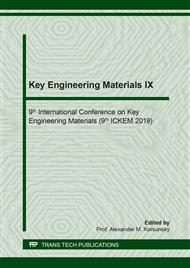p.39
p.47
p.54
p.59
p.67
p.74
p.81
p.89
p.96
Recycled HDPE/PET Clay Nanocomposites
Abstract:
Recycling waste plastics will support the preservation of natural resources and energy consumption. New challenges arise for the development of products that take advantage of solid waste. Upgrading recycled plastics using nanotechnology can tailor and consequently improve plastic properties for industrial applications. This research aims to process and relate the morphology and thermo-mechanical properties of recycled high-density polyethylene (rHDPE) and recycled polyethylene terephthalate (rPET) clay nanocomposites. Blends of rHDPE (75 wt %) coming from packaging and rPET (25 wt %) from bottles were mixed with two organoclays (Cloisite 20A and Cloisite 30B) (3 wt %) and a compatibilizer agent based on ethylene-glycidyl methacrylate (EGMA) (5 wt %). The recycled plastics nanocomposites were processed using a single-screw extruder incorporating a dispersive and distributive mixer and an injection molding machine. Several techniques were used to characterize the dispersion, morphology, mechanical properties and compatibilization of these composite blends. The reinforcing effect of rPET in the continuous rHDPE phase depended on the organoclay type and the compatibilizer additive. Both organoclays increased the stiffness and strength of rHDPE and rPET as evidenced by an increase in the corresponding Young modulus and ultimate tensile strength. EGMA increased the compatibility in the recycle plastics blend and in the clays nanocomposites as evidenced in elongation and energy at break results. On the other side, Cloisite 20A showed to be more compatible with EGMA than Cloisite 30B in these rHDPE/rPET blends based on the thermo-mechanical properties results.
Info:
Periodical:
Pages:
67-73
Citation:
Online since:
September 2019
Price:
Сopyright:
© 2019 Trans Tech Publications Ltd. All Rights Reserved
Share:
Citation:


